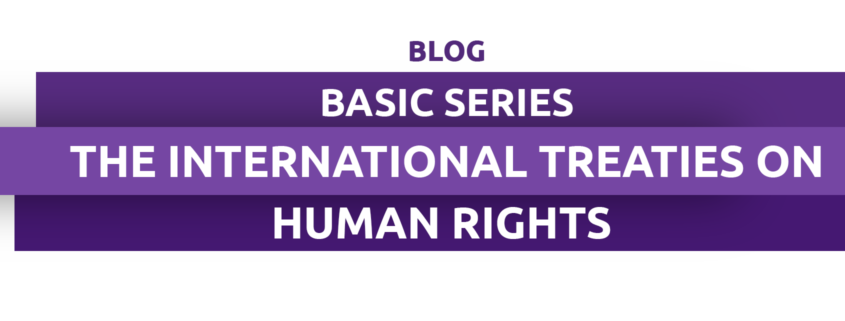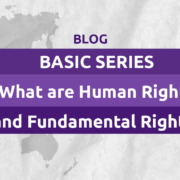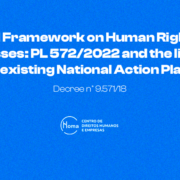The International Treaties on Human Rights
The International Treaties on Human Rights
As we have already seen, the human rights are rights that should be applied to every human being, simply because they exist, without any distinction of race, gender, nationality, culture, language and religion. That includes the right to life and liberty, freedom of opinion, the right to education and work, among others. Those rights have been achieved through time with demands and social revolutions that had as objective the access to material and immaterial goods that would make life more dignified. However, the application of the human rights concern political, economic and social interests, which are far from being surpassed, as well as racism, colonialism, and sexism, structural problems that are in our system.
As one of the most effective means of guaranteeing the commitment to the application of those rights, the States sign international treaties. Through these treaties, the subjects are responsible for achieving a certain objective in a formal and internationally recognized manner.
What are international treaties
The treaties, consolidated as source of the International Law by the article 38 of the Statute of the International Court of Justice in 1945 (we will soon talk more about the sources), are an important tool of the International Law, and considered the most effective of them, since they consist in commitments assumed by the signatories in a declared and binding manner.
In 1969, the Vienna Convention on the Law of Treaties was submitted by the UN General Assembly, and came into force in 1980 when it reached the minimum number of 35 States that ratified it. According to the Convention, that regulate the execution of the treaties in an international context, the treaty is an international agreement established in writing between States, and must follow the determinations of the International Law. It is mandatory the consent of all the State members so that the treaty may enter into force.
The representatives of the States that may establish an international agreement are also set by the Vienna Convention. Are representatives the ones that have a Full Power “letter” signed by State authorities -in Brazil’s case, signed by the President and approved by the Foreign Minister.
Don’t worry about that, later on we will explain more in-depth about what and how the treaties are created.
International treaties in Brazil.
All the international treaties signed by Brazil are available on the platform Concórdia – developed by the Foreign Ministry Divisão de Atos Internacionais, and Divisão de Informática. The access to it is public, you only have to access their website.
Below there are some of the international treaties of which Brazil is a signatory.
Pact of San José, Costa Rica:
The convention, ratified by Brazil in 1992, addresses the human rights, trying to consolidate the respect to the personal liberties, to fundamental guarantees of the human beings, social justice, and the full accomplishment of these rights in the jurisdiction of its signatories, the member countries of the Organization of American States (OAS). From it, we can also highlight the creation of the Inter-American Human Rights System. The Pact of San José is one of the most important international treaties ratified by Brazil, which caused significant changes in the internal law – one example is the prohibition of people being detained by debts.
UN convention on the Rights of Persons with Disabilities of 2008:
Ratified internally in 2009 by Brazil, its objective is to ensure and promote the rights and fundamental liberties of persons with disabilities, aiming its citizenship and social inclusion.
Convention on Tobacco Control:
The convention was proposed in May 1999 and came into force in February of 2005. It is the first international binding treaty on public health elaborated by the World Health Organization (WHO). It characterizes smoking as an epidemic with serious consequences for public health. The convention establishes a set of rules for the sale, advertising and control of tobacco, aiming to reduce the damage to health caused by the substance.
Belém do Pará Convention: Inter-american Convention on the Prevention, Punishment and Eradication of Violence Against Women, the convention aims to criminalize every form of violence against women. It was adopted by Brazil in June 1994 and decrees that every women have the right of being free of violence, both in the public and private sphere. It is the first international legally binding treaty that criminalize all forms of violence against women, and used as starting point for the federal law No. 11.340 (Lei Maria da Penha).
International Treaty on Human Rights and Business:
the treaty is still under negotiation, and can be considered a milestone toward the process of defending the Human Rights against violations committed by business. Homa is actively monitoring and participating in the negotiations of the treaty at UN. To find out more about the treaty, access the link and keep following our publications and our blog.












Trackbacks & Pingbacks
[…] International treaties are one of the sources of the International Law prescribed in Article 38 of the Statute of the International Court of Justice and regulated in the Vienna Convention of the law of treaties. These are international sources that are written, which means that they are normative, and, therefore, are considered by many as a more effective tool of International Law. We have already explained about treaties here. […]
[…] have already talked about international treaties in our blog. In general, international treaties are the main source of International Law. For the validation of […]
Leave a Reply
Want to join the discussion?Feel free to contribute!